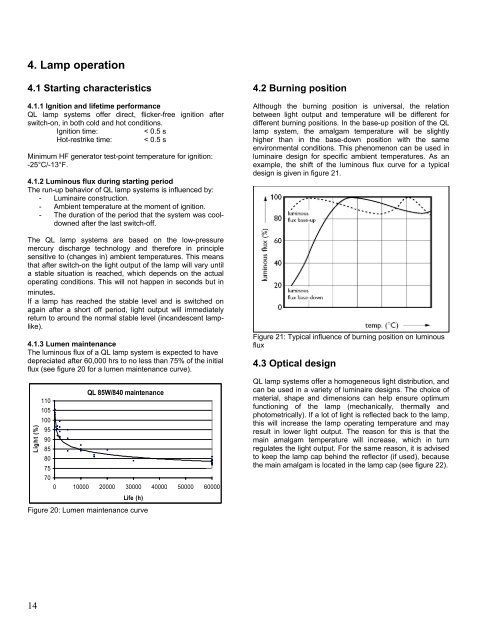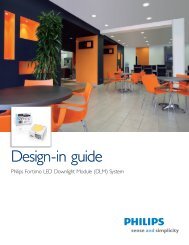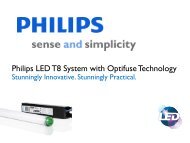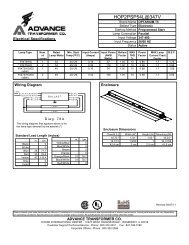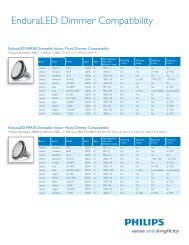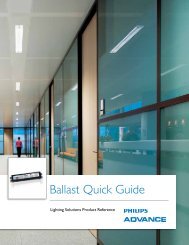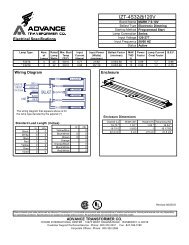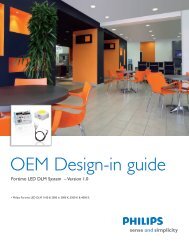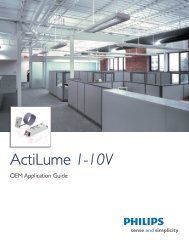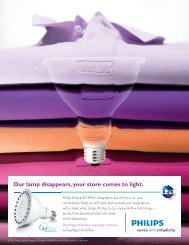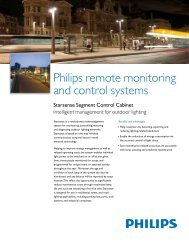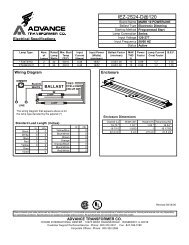Philips QL Induction Lighting Systems - Philips Lighting
Philips QL Induction Lighting Systems - Philips Lighting
Philips QL Induction Lighting Systems - Philips Lighting
- No tags were found...
Create successful ePaper yourself
Turn your PDF publications into a flip-book with our unique Google optimized e-Paper software.
4. Lamp operation<br />
4.1 Starting characteristics<br />
4.1.1 Ignition and lifetime performance<br />
<strong>QL</strong> lamp systems offer direct, flicker-free ignition after<br />
switch-on, in both cold and hot conditions.<br />
Ignition time:<br />
< 0.5 s<br />
Hot-restrike time: < 0.5 s<br />
Minimum HF generator test-point temperature for ignition:<br />
-25°C/-13°F.<br />
4.1.2 Luminous flux during starting period<br />
The run-up behavior of <strong>QL</strong> lamp systems is influenced by:<br />
- Luminaire construction.<br />
- Ambient temperature at the moment of ignition.<br />
- The duration of the period that the system was cooldowned<br />
after the last switch-off.<br />
The <strong>QL</strong> lamp systems are based on the low-pressure<br />
mercury discharge technology and therefore in principle<br />
sensitive to (changes in) ambient temperatures. This means<br />
that after switch-on the light output of the lamp will vary until<br />
a stable situation is reached, which depends on the actual<br />
operating conditions. This will not happen in seconds but in<br />
minutes.<br />
If a lamp has reached the stable level and is switched on<br />
again after a short off period, light output will immediately<br />
return to around the normal stable level (incandescent lamplike).<br />
4.1.3 Lumen maintenance<br />
The luminous flux of a <strong>QL</strong> lamp system is expected to have<br />
depreciated after 60,000 hrs to no less than 75% of the initial<br />
flux (see figure 20 for a lumen maintenance curve).<br />
Light (%)<br />
<strong>QL</strong> 85W/840 maintenance<br />
110<br />
105<br />
100<br />
95<br />
90<br />
85<br />
80<br />
75<br />
70<br />
0 10000 20000 30000 40000 50000 60000<br />
Life (h)<br />
Figure 20: Lumen maintenance curve<br />
4.2 Burning position<br />
Although the burning position is universal, the relation<br />
between light output and temperature will be different for<br />
different burning positions. In the base-up position of the <strong>QL</strong><br />
lamp system, the amalgam temperature will be slightly<br />
higher than in the base-down position with the same<br />
environmental conditions. This phenomenon can be used in<br />
luminaire design for specific ambient temperatures. As an<br />
example, the shift of the luminous flux curve for a typical<br />
design is given in figure 21.<br />
Figure 21: Typical influence of burning position on luminous<br />
flux<br />
4.3 Optical design<br />
<strong>QL</strong> lamp systems offer a homogeneous light distribution, and<br />
can be used in a variety of luminaire designs. The choice of<br />
material, shape and dimensions can help ensure optimum<br />
functioning of the lamp (mechanically, thermally and<br />
photometrically). If a lot of light is reflected back to the lamp,<br />
this will increase the lamp operating temperature and may<br />
result in lower light output. The reason for this is that the<br />
main amalgam temperature will increase, which in turn<br />
regulates the light output. For the same reason, it is advised<br />
to keep the lamp cap behind the reflector (if used), because<br />
the main amalgam is located in the lamp cap (see figure 22).<br />
14


